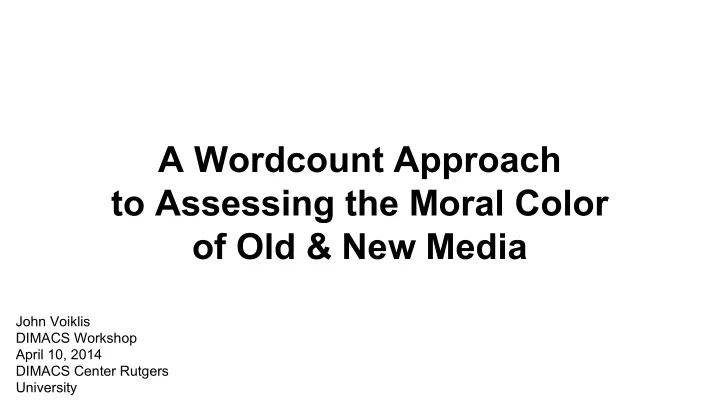

A Wordcount Approach to Assessing the Moral Color of Old & New Media John Voiklis DIMACS Workshop April 10, 2014 DIMACS Center Rutgers University
It ain’t in the word counts; it’s in the dictionary Counting words appears to suffice for... ...detecting… ...personality traits [1] ...deception [2] , etc. ...predicting... ...future mental health [3] ...relationship stability [4] , etc. ...comparable results to more sophisticated (lexical) methods [5] . How? A dictionary derived from a domain-relevant theory does all of the work of detection/prediction in each case.
Developing a dictionary from Moral Foundations Theory
The moral color of television
Conservative complaints about TV bias might be right
Social media as data about behavior & as behavior Social media can serve both as data & as laboratory. In either case its usefulness derives from social (psychological) theory. As data , social media helps in testing social (psychological) theories by recording the unfolding of social interactions. eg., does TV exert a cumulative influence on viewers [7] ? As behavior : social media requires social (psychological) theories for making sense of those unfolding interactions. Does a post , a like , an un/friending , etc. constitute... ● an assertion of values, ● a value judgement of another’s behavior, or ● an attempt to regulate that behavior?
References 1. Pennebaker, J. W. and King, L. A. (1999). Linguistic styles: Language use as an individual difference. Journal of Personality and Social Psychology, 77(6):1296-1312. 2. Newman, M. L., Pennebaker, J. W., Berry, D. S., and Richards, J. M. (2003). Lying words: Predicting deception from linguistic styles. Personality and Social Psychology Bulletin, 29(5): 665-675. 3. Stirman, S. W. and Pennebaker, J. W. (2001). Word use in the poetry of suicidal and nonsuicidal poets. Psychosomatic Medicine, 63(4):517-522. 4. Ireland, M. E., Slatcher, R. B., Eastwick, P. W., Scissors, L. E., Finkel, E. J., and Pennebaker, J. W. (2011). Language style matching predicts relationship initiation and stability. Psychological Science, 22(1):39-44. 5. Gonçalves, P., Araújo, M., Benevenuto, F., and Cha, M. (2013). Comparing and combining sentiment analysis methods. In Proceedings of the First ACM Conference on Online Social Networks, pages 27-38, New York, NY, USA. ACM. 6. Graham, J., Haidt, J., and Nosek, B. A. (2009). Liberals and conservatives rely on different sets of moral foundations. Journal of Personality and Social Psychology, 96(5):1029-1046. 7. Shrum, L. J. (2009). Television viewing and social reality: Effects and underlying processes. In Wänke, M., editor, Social Psychology of Consumer Behavior, pages 251-272. Psychology Press, New York.
Recommend
More recommend